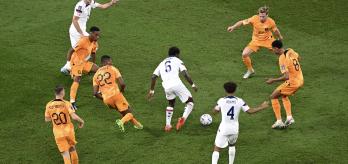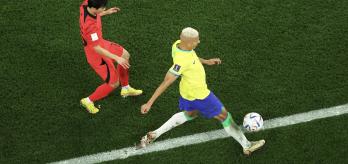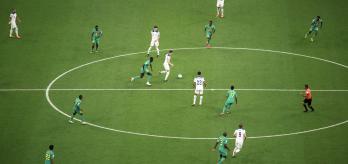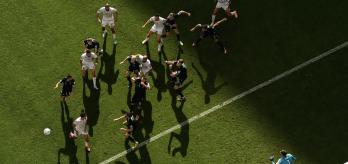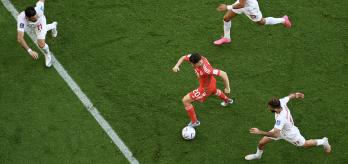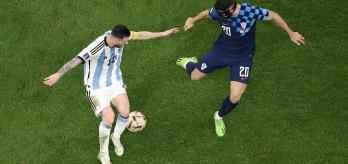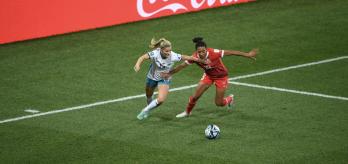Key points
-
High-intensity and sprint distances during the FIFA World Cup Qatar 2022™ matches were greatest for the USA and lowest for Costa Rica.
-
Japan demonstrated the most match-to-match variation for the distance covered in total and the distance covered at higher intensities.
-
Based on quadrant plots, the USA, IR Iran and Canada were classified as teams that produced high volumes and high explosiveness during matches, while Costa Rica and Ecuador were the opposite.
Benchmarking teams
A basic approach to analysing the physical demands of a team is to simply report "what" distance they covered overall and specifically the distance covered at higher speeds1,2. Although this approach can be one-dimensional at times, practitioners can still glean some fascinating insights from such analyses. For benchmarking purposes, on average, teams during the FIFA World Cup Qatar 2022™ covered 108.1km in total, with 9,001m and 2,345m covered at the higher intensities (>20km/h and >25km/h), respectively.
Moreover, the physical performances of teams at the upper and lower extremes also reveal some interesting insights. For instance, Figure 1 highlights that the USA, IR Iran and Australia covered the greatest overall distance in games, while Argentina, Mexico and Ecuador covered the lowest overall distance. In Figures 2 and 3, it is noteworthy that the distance covered at higher intensities (>20km/h and >25km/h) was greatest for the USA, and this was around 50-100% more than Costa Rica, who covered the lowest distances in the upper speed zones.
Much-needed context is provided in these figures by highlighting the specific games that resulted in the highest and lowest demands for the whole tournament. The trends in Figures 1-3 were not fundamentally different when the distances were adjusted for the overall match duration (e.g. m/min), hence the reason for presenting most of the data in absolute terms (e.g. m or km). Exceptions were teams that played much longer match durations of more than 108 minutes (IR Iran and Saudi Arabia) or shorter durations of less than 100 minutes (Morocco, Brazil and Croatia) compared to the average.
The importance of tactical context and opposition
Caution is always needed when interpreting these physical trends as these findings are not necessarily indicative of differences in the physical fitness levels of the above teams, but possibly related to the style of play employed by each side plus many other factors. For instance, the USA frequently transitioned, which required players to produce long linear high-intensity runs, whilst Costa Rica frequently sat in a defensive low or mid-block for extended periods, thus reducing their opportunity to move into space to engage in high-intensity activities3.
This is understandable as the aim of any team's tactics is to ensure optimal team organisation in order to best utilise the physical and technical capabilities of its players4. Thus, this trend could simply reflect the stylistic tendencies of each team, and this will be covered in greater detail in the "why" section later. However, all teams playing in the upper echelons of the game typically have adequate fitness levels, but various tactics and the quality of the opposition may require them to up or downregulate their physical exertions accordingly.
Match-to-match variation
The data visuals in Figures 1-3 also depict the match-to-match variation of each team in the FIFA World Cup Qatar 2022. This indicates the consistency of each team's physical exertions across the tournament (the yellow dots signify the physical performance in each game). The scattered trend of yellow dots across most teams indicates that physical performances are highly variable from one game to the next, and this is in line with previous research5.
The most consistent teams from a physical perspective were highly dependent on the metric. For instance, Ghana, Ecuador and Uruguay were particularly consistent for total distance, high-intensity (>20km/h) and sprint distances (>25km/h), respectively.
Japan's match-to-match variation as a case in point
It is noteworthy that Japan exhibited the most variation from game to game for the distance covered in total and the distance covered at higher intensities (>20km/h and >25km/h). The opposition that Japan played against at the upper and lower ends of the range provides much-needed context. Japan covered their greatest distances in total and at higher intensities against Germany because the duration of that match was much longer than their other games. Japan covered most of this distance while out of possession (they only had 22% possession) in a reactive attempt to press Germany and force turnovers.
In contrast, Japan covered their lowest distances in total and across higher intensities (>20km/h and >25km/h) against Costa Rica. Japan covered more distance while in possession (and had 49% possession) across metrics in this game due to the defensive low/mid-block tactics that Costa Rica employed. Thus, Japan were able to dictate play more, as evidenced by their highest number of build-ups, progressions and movements to receive of their tournament.
Although this will be explored in greater detail in the "why" section, one of the most influential factors dictating a team's work rate is the opposition they play against, and this example supports that assertion.
Team quadrant analysis of volume versus explosiveness
This data set can be viewed from a different perspective by correlating two distinct dimensions of physical performance using a quadrant plot. This produces four clear-cut quadrants that will allow practitioners to determine which teams are more volume-based and which are more explosive-based by plotting the total distance against the distances covered at higher intensities (>20km/h and >25km/h). Figures 4 and 5 show that the USA, IR Iran, Germany and Canada are in the upper-right quadrant as they covered considerable distance in total and at upper intensities during games (i.e. high volume and high explosiveness). In contrast, Costa Rica and Ecuador are in the lower-left quadrant and thus covered noticeably lower distance overall and at higher intensities (i.e. low volume and low explosiveness).
The most striking example of a team that covered low distance overall but was highly explosive based on their high-intensity and sprint distances (>20km/h and >25km/h) was Saudi Arabia, who are in the upper-left quadrant (i.e. low volume and high explosiveness). Australia and Serbia, meanwhile, covered sizeable distances in total but covered much lower distances at the higher speeds (>25km/h; i.e. high volume and low explosiveness). This information could aid practitioners' preparations prior to games by categorising opposition in this manner. The link between physical and tactical trends will be explored later in the "why" section.
References
-
Bradley PS, Ade JD. Are current physical match performance metrics in elite soccer fit for purpose or is the adoption of an integrated approach needed? International Journal of Sports Physiology and Performance. 2018, 13: 656-664.
-
Ju W, Doran D, Hawkins R, Gómez-Díaz A, Martin-Garcia A, Ade J, Laws A, Evans M, Bradley P. Contextualised peak periods of play in English Premier League matches. Biology of Sport. 2022, 39: 973-983.
-
Ju W, Doran D, Hawkins R, Evans M, Laws A, Bradley PS. Contextualised high-intensity running profiles of elite football players with reference to general and specialised tactical roles. Biology of Sport. 2023, 40: 291-301.
-
Bradley PS, Noakes TD. Match running performance fluctuations in elite soccer: indicative of fatigue, pacing or situational influences? Journal of Sports Sciences. 2013, 31: 1627-1638.
-
Bush MD, Archer DT, Hogg R, Bradley PS. Factors influencing physical and technical variability in the English Premier League. International Journal of Sports Physiology and Performance. 2015, 10(7): 865-872.











